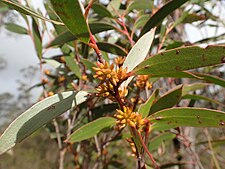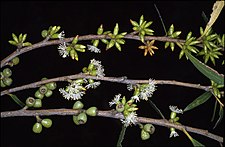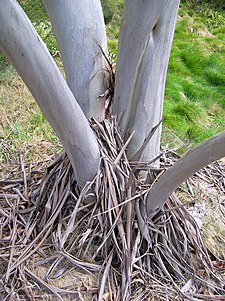ar
الأسماء في صفحات التنقل


Eucalyptus moorei (lat. Eucalyptus moorei) - mərsinkimilər fəsiləsinin evkalipt cinsinə aid bitki növü.
Eucalyptus moorei, commonly known as narrow-leaved sally,[2] is a species of mallee that is endemic to New South Wales. It has smooth bark, linear to narrow lance-shaped or curved adult leaves, flower buds in groups of between seven and fifteen, white flowers and cup-shaped or shortened spherical fruit.
Eucalyptus moorei is a mallee that typically grows to a height of 6–10 m (20–33 ft) and forms a lignotuber. Young plants and coppice regrowth have sessile leaves arranged in opposite pairs, linear to oblong 28–45 mm (1.1–1.8 in) long and 6–25 mm (0.24–0.98 in) wide. Adult leaves are arranged alternately, linear to narrow lance-shaped or curved, the same glossy green on both sides, 30–90 mm (1.2–3.5 in) long and 4–13 mm (0.16–0.51 in) wide on a petiole up to 8 mm (0.31 in) long. The flower buds are arranged in clusters of between seven and fifteen in leaf axils on an unbranched peduncle 1–7 mm (0.039–0.276 in) long, the individual buds sessile, or on a pedicel up to 1 mm (0.039 in) long. Mature buds are top-shaped, 5–7 mm (0.20–0.28 in) long and about 2 mm (0.079 in) wide with a conical to horn-shaped operculum. Flowering occurs between February and May and the flowers are white. The fruit is a woody cup-shaped or shortened spherical capsule 4–5 mm (0.16–0.20 in) long and 3–6 mm (0.12–0.24 in) wide with the valves enclosed below the level of the rim.[2][3][4][5]
Eucalyptus moorei was first formally described in 1905 by Joseph Maiden and Richard Hind Cambage from a specimen collected "on the highest parts of the Blue Mountains" and the description was published in Proceedings of the Linnean Society of New South Wales.[6][7]
In 1999, Ian Brooker and David Kleinig described two subspecies of E. moorei, distinguished by the size and shape of their juvenile leaves, that have been accepted by the Australian Plant Census:
The National Herbarium of New South Wales lists Eucalyptus dissita K.D.Hill as a species separate from E. moorei and occurring only in the Gibraltar Range National Park the Australian Plant Census lists it as a synonym.[10]
The specific epithet (moorei) honours Charles Moore[2] and dissita is a Latin word meaning "apart" or "remote".[11] The name serpentinicola refers to the unusual habit of this subspecies that only grows in hills of red soil over serpentinite.[2]
Narrow-leaved sally grows in sandy soil in heath, sometimes on poorly drained sites or on exposed sandstone. It is found in the Gibraltar Range, Blue Mountains, Tinderry Range and in the Wadbilliga National Park. Subspecies serpentinicola is only known from an area near Gloucester.[2][4]
Eucalyptus moorei, commonly known as narrow-leaved sally, is a species of mallee that is endemic to New South Wales. It has smooth bark, linear to narrow lance-shaped or curved adult leaves, flower buds in groups of between seven and fifteen, white flowers and cup-shaped or shortened spherical fruit.
 flower buds and foliage
flower buds and foliage flowers and fruit
flowers and fruit base of trunk
base of trunk
Eucalyptus moorei là một loài thực vật có hoa trong Họ Đào kim nương. Loài này được Maiden & Cambage mô tả khoa học đầu tiên năm 1905.[1]
Eucalyptus moorei là một loài thực vật có hoa trong Họ Đào kim nương. Loài này được Maiden & Cambage mô tả khoa học đầu tiên năm 1905.
Eucalyptus moorei Maiden & Cambage
Дочерние таксоныЭвкалипт Мурея (лат. Eucalyptus moorei) — вечнозелёное дерево, вид рода Эвкалипт (Eucalyptus) семейства Миртовые (Myrtaceae).
В природе ареал охватывает восток Австралии — субальпийский пояс Голубых гор до 1200 м над уровнем моря. Растёт на песчано-каменистых почвах. На родине нередко образует густые, кустообразные заросли.
Морозоустойчивость относительно высокая. В однолетнем возрасте выдержал без повреждений мороз в 6—8 °C.
Относительно хорошо растёт на глинистых, пересыхающих склонах, где за три года достигает высоты в 1,5—3 м. Лучше растёт на глубоких, питательных, умеренно влажных почвах.
Дерево высотой до 7 м, с прямым, тонким стволом.
Кора гладкая, опадающая.
Молодые листья супротивные, в количестве нескольких пар, сидячие, узко ланцетные, слегка сизые, длиной 2—3 см, шириной 0,5—0,8 см. Взрослые очерёдные, черешковые, узко ланцетные, на вершине крючковатые, утолщенные, бледно-зелёные, длиной 4—7 см, шириной 0,5—1 см.
Зонтики пазушные, 7—12-цветковые, сидящие на коротких ножках; бутоны сидячие, цилиндрическо-клювовидные, длиной 6—8 мм, диаметром 3 мм, с конической или клювовидной, крышечкой, равной трубке цветоложа или несколько длиннее её.
Плоды сидячие, шаровидные, усечённые, длиной 3—4 мм, диаметром 4—6 мм, с неотчетливым диском и мелкими, дельтовидными, чаще вдавленными створками.
На родине цветёт в декабре — феврале; на Черноморском побережье Кавказа — июле — августе.
Древесина белая, прочная.
В листьях содержится эфирное (эвкалиптовое) масло (0,8 %).
В рамках вида выделяют несколько подвидов и разновидностей[2]:
Вид Эвкалипт Мурея входит в род Эвкалипт (Eucalyptus) подсемейства Миртовые (Myrtoideae) семейства Миртовые (Myrtaceae) порядка Миртоцветные (Myrtales).
Эвкалипт Мурея (лат. Eucalyptus moorei) — вечнозелёное дерево, вид рода Эвкалипт (Eucalyptus) семейства Миртовые (Myrtaceae).